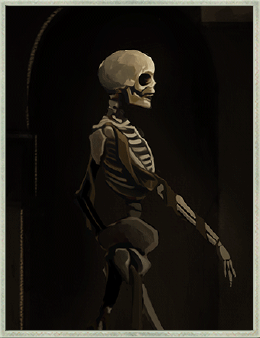The Museum of Mistakes: Difference between revisions
m Per request; add {{Scroll box}} to references, replaced: <references /> → {{Scroll box|text=<references/>}} |
m →References: Per request, remove deprecated categories, removed: Category:Unformatted |
||
| Line 26: | Line 26: | ||
[[Category:Places]] | [[Category:Places]] | ||
[[Category:London]] | [[Category:London]] | ||
[[Category:The Neath]] | [[Category:The Neath]] | ||
{{Scroll box|text=<references/>}} | {{Scroll box|text=<references/>}} | ||
Revision as of 06:47, 16 May 2023
"Everyone has heard of the Museum of Mistakes. Hardly anyone has been inside it."[1]

The Museum of Mistakes is a dusty old institution on Ladybones Road[2] run by the Ministry of Public Decency,[3] and a d__nable pain to actually get into. It holds all sorts of ancient things, reminders of old indiscretions and errors.
Halls of Shame
The Museum has seventy-seven doors, but not all of them are real; some are just painted onto the wall, while others hold traps designed to give any intruder a really miserable day.[4] Perhaps it’d be best to enter legitimately… but that might be an even more difficult task, given the bureaucratic labyrinth[5] that is the nine-stage application process.[6][7]
The following are known to be on display in the Museum:
- A corroded brass microscope smelling faintly of ammonia[8]
- Old musket-balls[9]
- Jade carvings[10]
- A half-eaten fig[9][11]
- A three thousand year old bit of black sailcloth,[9] labelled 'Achaean, c 1200BC'[11]
- First City Coins[9]
- Diamonds[9]
- A stuffed two-headed bat[11]
- Two locks of hair; one amber, one dark.[11]
Grim Reminders
The Dadd Wing contains the museum's collection of human remains[12][13] and requires a separate ticket to enter.[14] It houses glass cases, sarcophagi,[15] the skin of of human faces,[16] part of a skull,[17] and its oldest exhibit,[18] a collection of ushabti and canopic jars donated by one Troubled Painter.[19]
This mysterious painter lives in the Royal Bethlehem Hotel, and his name is implied to start with an R;[20] he may be Richard Dadd, the namesake of the exhibit. In real life, Dadd was a troubled but prolific illustrator who produced most of his best-known work while in psychiatric hospitals (one of which was Bethlem Royal Hospital).[21]
References
|